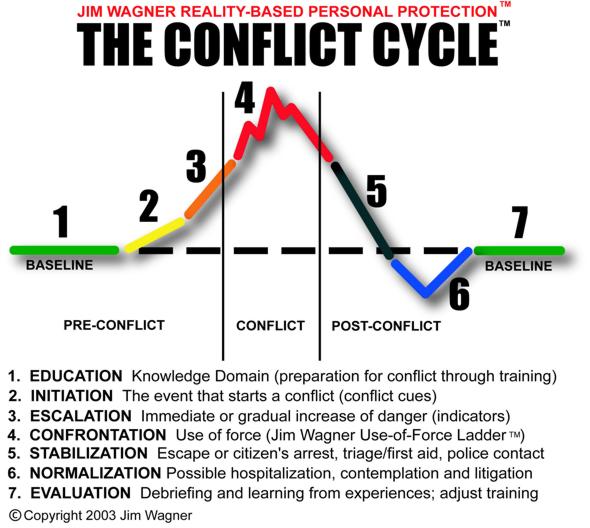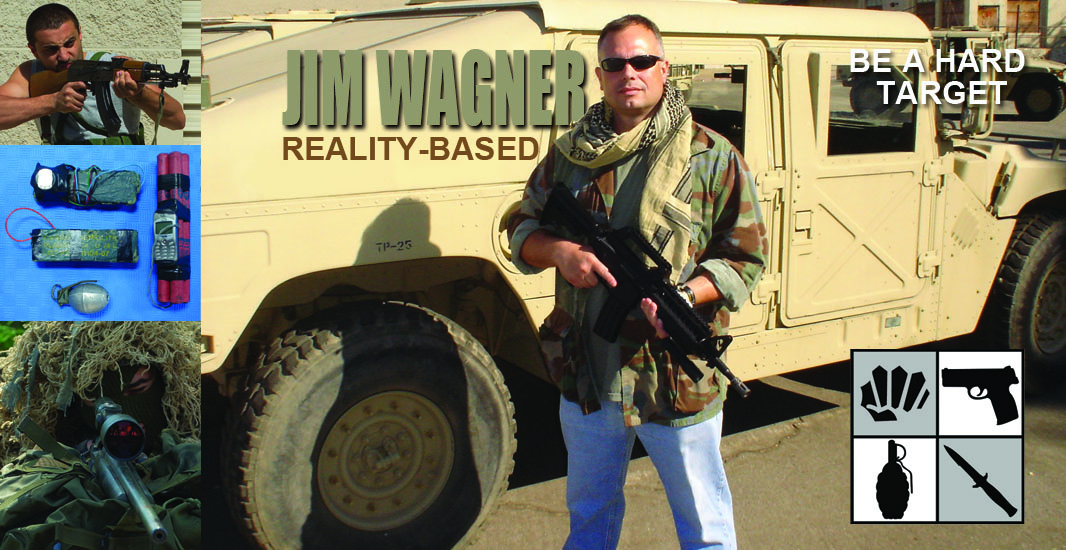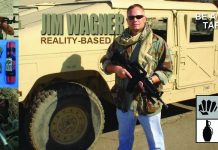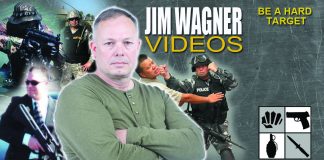Any human conflict that you engage in will have a predictable cycle. Whether the conflict involves a heated argument with a hostile subject or taking down a terrorist in a life and death situation, the cycle is always the same and always goes in sequential order. Obviously the type of conflict, and how you deal with it, will determine the time and intensity one spends in each phase of the cycle. Having seen a great deal of action as a corrections officer and a police officer, I have experienced the cycles of conflict more times than I can remember. Over the years I have also noticed that all conflict shares a common pattern. As I developed my Reality-Based Personal Protection system for civilians I spent years thinking about this cycle and working and reworking a graph that would best display this cycle in a simple, yet comprehensive, fashion. The finalized result is THE CONFLICT CYCLE.
Up until I developed my system (integrating techniques and training methods of criminals, terrorists, law enforcement, corrections and the military), and introduced it publicly through Black Belt magazine (USA) in 1999 and in Budo (Europe) in 2000, very few self-defense instructors bothered to educate or train their students in the complete spectrum of conflict. They taught the conflict essentials of moving, blocking and striking, but failed to inform their students about Pre-Conflict and Post-Conflict phases. Even when teaching conflict itself many instructors today still do not know how to articulate the steps that a conflict takes. Obviously the primary reason for this omission is that most civilian martial arts instructors simply lack a legal background as it relates to use-of-force issues. The Conflict Cycle is an excellent tool for the martial arts student who wants to know the specific steps that a conflict will take, and this graph is perfect for instructors who wish to prepare their students physically, mentally, and emotionally for every phase of a conflict, and not just the “punching and kicking” aspects of self-defense training.

The Graph
The Conflict Cycle graph is divided into three components: Pre-Conflict (before the conflict), Conflict (whether visually, verbally or physically), and Post-Conflict (after the conflict). Within each section there are numbered and color coded lines.
The numbering and color code system of The Conflict Cycle are detailed elements within each conflict component. Although actual conflict is a seamless event, the individual lines help to explain specific events that will take place within the timeline. This will not only let you know what to expect in a real fight, but how to better analyze what transpired in a logical sequence after the conflict (after action).
The baseline, indicated on the graph by a black dashed line, extends to infinity in both directions. It represents your normal daily life without conflict. The baseline represents your normal behavior, thought patterns, and habits. It is the constant.
1. Education
The green line that sits on the baseline represents our preparation before a conflict. Everybody prepares for a conflict one way or another. Not preparing for a conflict is still doing something nothing.
Although it is impossible to predict the future, you can prepare for the types of conflict that you are most likely to face; in other words, “your reality” (this is why the third branch of the martial arts is referred to as “reality-based,” while the other two branches of the martial arts are traditional-based and sport-based). The types of conflict that you are likely going to face (threat profile) will depend on your environment and your purpose. The businessman living in Baghdad, Iraq has a different reality then that a housewife in a small town in Nebraska, USA. Thus, the risks and the dangers will differ in nature and intensity from person to person. Changing either your environment or your purpose will change your reality. Either way, proper preparation will help you meet the challenge if you are faced with a conflict.
In the Jim Wagner Reality-Based Personal Protection system we refer to Pre-Conflict preparation as Knowledge Domain. This is a set of facts, drills and exercises that every true practitioner of self-defense must know. For example, “What is the difference between being a “hard target” and being a “soft target?” The criminal or terrorist is going to know, and so should you. Knowledge Domain includes training in such disciplines as counter-surveillance (how to know if someone is targeting or falling you), legal issues, physical and mental conditioning, the K.I.M.S. game (Keep In Memory System), the *O.O.D.A. process (Observe, Orient, Decide, Act), the Use-of-Force Ladder, the optimum training environment, and more.
2. Initiation
The yellow line corresponds with my color code system and the Jim Wagner Use-of-Force Ladder, and it means CAUTION. Conflict does not just happen, there has to be a starting point. Sometimes you will see it coming, and other times it will be on you instantly. The more familiar you are with various forms of violence, the more perceptive you will be at spotting the initial phase of a conflict (conflict cues). For example, if you see a man walk into a bank wearing a baseball cap and sunglasses, and he did a 60 degree scan of the area before entering, that may be the cue that he is about to do a bank robbery, and your signal to prompt you to start making your way to an exit or position yourself near some cover (something that will protect you from bullets and fragmentation, and hopefully hide your position). Initiation can be as simple as someone looking at you wrong, or as complex as a couple of terrorists making subtle hand signals to each other moments before a surprise attack.
3. Escalation
After initiation there will be escalation, which is represented by the orange line. Orange means that a conflict is imminent. Escalation can be immediate, such as a terrorist pulling a box cutter from their waistband on a bus, or gradual where somebody starts to raise their voice at you in a hostile manner. These are strong warning signs that cannot be ignored. How far the escalation goes up the Use-of-Force Ladder depends on the nature of the conflict. Sometimes you will be able to diffuse an escalating situation, and other times you will have no choice but to merely react to it. Just as in the initiation element, hopefully your training and experience is enough to detect the escalation, and you will be able to counter it in time.
4. Confrontation
This is the phase where physical conflict takes place, and it is represented by the color red (for danger). The line goes up and down like a mountain range, because a fight can go up and down. One second you can be losing, the next moment you are winning, and then you’re losing the advantage once again. This is the point where your martial arts training will be put to the test. If your past training closely parallels the incident you find yourself in, then you will be better prepared for it. If, on the other hand, your training was unrealistic and fanciful this will obviously be a disadvantage and could prove disastrous. Over the years I’ve had many black belts in traditional-based systems come up to me and tell me that they had trained hard for years, but were defeated in a real-life encounter for one reason or another: they were not prepared for the attacker to throw sand in their eyes, the attacker kept thrusting the knife at angles they weren’t expecting, they weren’t used to fighting with objects littering the ground, and the list goes on. These same people are the ones who became advocates of learning various styles (hybridization), and later reality-based; be it my system or a similar system.
You will also notice that the red line extends into the Post-Conflict component slightly. This is because you are not truly safe until you have completely escaped from the threat, your attacker is no longer a threat (they escaped or are incapacitated), or you have subdued the attacker(s) until the authorities have arrived. You may have indeed made a successful citizen’s arrest after the fight, and you have crossed over into the Post-Conflict phase, but until you hand over your prisoner to the police the suspect still poses a threat (they can break free, possibly strike you even under restraints, escape, etc.) Even if the suspect runs from the scene, did they really flee or are they just going around the corner to retrieve a weapon and double back on you. Therefore, one must still stay alert even after the initial hostilities have ended. One more glaring illustration is a suicide bomber. You may have survived the blast, but you had better clear out of the area in case there is a second suicide bomber who plans on killing the first responders.
5. Stabilization
The gray line begins the Post-Conflict phase; the color gray because their may be uncertain variables at this stage (gray area). Now that the conflict is over, what do you do with the suspect? Do you walk away? Do you flee for your life? Do you make a citizen’s arrest? You can’t just bow, get a few pointers from the instructor, and catch your breath while watching the next group spar like many traditional-based martial arts schools inadvertently teach their students to do (unrealistic conditioning). This phase is also a time for self triage or self first aid if there are injuries. If a crime had taken place (if it went to number 4 on the Use of Force Ladder, then a crime has taken place), then there will be police contact; whether you notify the authorities yourself or they show up from another caller. Has your training prepared you in making a police report, taught you how to respond under questioning, or how to keep yourself from making self-incriminating statements? The only contact that most people have ever had in their life with the police is a traffic violation. Entering their world can be an intimidating thing if you do not receive proper training.
6. Normalization
Depending on how severe the conflict was, will determine how far you dip below the base line; represented by the blue line (I made it this color because you can feel very “blue” during this time). This is an area virtually ignored by the modern martial arts instructors, but very much addressed by the professions who fight for a living.
At this point the conflict is over and your mind and body seeks to return to its baseline (normal life). If serious injuries were sustained there can be hospitalization. Another casualty can be your own psychological health in the form of Post Traumatic Stress Disorder or Conflict Fatigue. Depending on how traumatic the conflict was, you may experience fear, fatigue, regret, performance disappointment, depression, or any number of negative emotions. How long you stay below the baseline depends on a lot of things: your general outlook on the situation, your previous training and experiences, and your support group. The more familiar you are with conflict the less time you spend below the baseline. Experiencing time below baseline is normal, but too long there can lead to some serious problems. One of the greatest strengths of Jim Wagner Reality-Based Personal Protection system is that we expose people to very realistic conflict scenarios, which because of its true-to-life realism (using costumes, environmental manipulation, scents, props, scripts, etc.) it gives students a taste of this phase of The Conflict Cycle under controlled conditions. Therefore, these experiences will not be as foreign to them when they face the real thing.
7. Evaluation
At some point life does return back to “normal,” or as normal as it can be. The baseline is once again reached, and is subsequently indicated by a green line. The conflict experience can either make the person grow or it can demoralize them and they retain the victim mentality. For some, conflict it is a wake up call, and an opportunity to adjust their training accordingly. This phase of The Conflict Cycle does not only occur after real life situations, but training can induce this part of the cycle as well. Here is a case in point. I have been in real knife fights were people wanted to kill me. I have seen actual stabbings, and I have trained thousands of police officers, SWAT operators, and Special Forces operators in Knife Survival. I have had many martial artists, from every kind of style you can imagine, totally change they way they train to defend against edged weapons after I showed them how real criminals or terrorists use a knife, or shank, to maul someone. These “converts” went through a realistic training environment attack, experienced the six elements of The Conflict Cycle, and then decided to change their training regime to reflect their newly founded knowledge. Ultimately, that is what stage number 7 has to be; a time of evaluation and constant restructuring.
I have included a free download of the Jim Wagner Conflict Cycle graph for your own personal use. You may use this copyrighted graph, as long as it is used in its entirety and no modifications are made to it, for teaching private lessons and group lessons within a legally recognized self-defense school. Any other use requires written permission.
Be A Hard Target.




